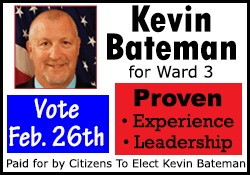|
In rural Mississippi, still waiting on
recovery
 Send a link to a friend
Send a link to a friend
 [February 14, 2019]
By Howard Schneider [February 14, 2019]
By Howard Schneider
ITTA BENA, Miss (Reuters) - Here’s what has
happened in Leflore County, Mississippi, since the end of the U.S.
recession in 2009.
The number of jobs fell 4 percent and nearly 8 percent of the businesses
disappeared. Average annual pay at private firms stalled. The median age
spiked a full three years as working age adults voted with their feet
and left. Home ownership rates tipped from just over half of families to
below it.
The United States' record-setting and near-decade-long recovery from the
2007 to 2009 recession has restored many measures of the national
economy back to or better than what they were.
But it has done little for Leflore County, or for many rural places like
it whose continued slip from the economic mainstream worries Federal
Reserve and other policymakers who fear it could feed broader problems,
from slower growth overall to increased political tension.
"We say we are close to maximum employment and at the national level we
are," Fed chairman Jerome Powell said in remarks to a conference here on
rural poverty earlier this week. "There are pockets that are not. The
obvious way to grow the size of the economy is to bring people in that
are at the edges...Make it easier for people to get into the labor force
and stay in the labor force."

But he said long-run trends, particularly rural population decline, were
creating a dynamic that may be difficult to break, as fewer people leads
to fewer businesses and jobs, and gives people more cause to leave. In
the midst of that, banks have pulled back as well.
Added up across the country, Powell said, it becomes a broader risk to
growth if aspiring entrepreneurs in small towns can't get the credit or
counsel they need to build sustainable businesses.
The event was held at Mississippi Valley State University, outside this
rural town of around 2,000 residents, amid rain-flooded fields and
catfish farms. Near the birthplace of blues legend B.B. King, Itta
Bena's main street today is largely shuttered.
Powell is the second ranking Fed official to visit here in recent years.
He did not come armed with any striking new policy ideas, beyond sound
monetary policy, good bank supervision, and modest changes to the
Community Reinvestment Act.
But his presence is part of a growing focus at the Fed around community
development and related research indicating that widening economic gaps
between successful and less-successful communities could impair the
country's overall performance.
Researchers have connected a drop in economic mobility in the United
States to factors related to "place" - the notion that where individuals
are born, by shaping school, early work opportunities, and health, for
example, is coming to have a disproportionate influence on their
economic success.
Others at think tanks like the Brookings Institution and the Economic
Innovation Group have found that the benefits of the recovery have been
concentrated in high-performing urban areas and already prospering zip
codes.

In a study last fall, for example, the EIG looked at federal data and
found a handful of places like Los Angeles, Miami and Houston accounted
for all the net growth in new businesses since the recession.
"We have an economy now that rewards agglomeration, knowledge
spillovers, and density. You either have those and are growing and
prosperous or not," said EIG president John Lettieri. "You have a narrow
set of places propping up the national economy."
[to top of second column]
|

The view of a street in downtown Itta Bena, Mississippi, U.S.,
February 11, 2019. REUTERS/Howard Schneider

MISSISSIPPI BLUES
It's an issue the registers deeply in the Mississippi Delta, a
region that's perennially the poorest in a state that often ranks at
the bottom of national economic indicators. The median family income
in Leflore County, at around $23,600, is the 23rd lowest in the
nation and less than a fourth of what it is in Powell's childhood
and current hometown of Montgomery County, Maryland.
If some parts of the south have emerged from the crisis with a new
vibrancy, often driven by courting overseas capital and new
industries, success here is being measured in smaller doses - in the
fight to get a convenience store to stock fresh produce, for
example, to make up for the lack of a proper grocery.
One partnership funded by Goldman Sachs through a local credit union
and development corporation is rehabbing a small neighborhood which
a private developer had left in disrepair, with open sewage in the
streets and regular electrical fires.
It's a recognition that a first hurdle in improving the economy in
places like LeFlore County may be fixing some of the problems that
caused the population to fall more than 10 percent over the last
decade or so, said Bill Bynum, chief executive of the Hope Credit
Union Enterprise Corp., which is overseeing the redevelopment of the
small Eastmoor community.
"It is devastating on small towns if you see grocery stores close,"
said Bynum, whose organization has put full service branches in
towns that had been limited to ATMS and check cashing services.
"People are concerned what the future is going to be like for their
children. Are they going to be able to survive in places like Itta
Bena and Moorhead?"
Those concerns are heard along the boarded-up Main Streets of many
small towns in the south, the region where most of the counties that
suffer long-term persistent poverty are located.
But it isn't unique to the region. Small towns in upstate New York
or central Ohio are under similar pressure; in rural Minnesota, as
heavily white as the Mississippi Delta is heavily black, small
downtowns have also been abandoned, and local anxiety stoked by
issues like a hospital's decision to relocate a county away.

"There has been more of a recognition that what happens in
low-income communities bubbles up," said Daniel Davis, assistant
vice president and community affairs officer at the St. Louis
Federal Reserve bank. The average family in the this part of
Mississippi, for example, is spending 40 percent of its household
budget on housing, well above the national average, and "it makes it
harder to save, for the future, for college, to make the decisions
that households with more 'padding' can make."
The ability of monetary policy to affect local outcomes is limited,
since the Fed's main influence on the economy is through national
financial markets. Some argue that the Fed's two years of hiking
interest rates may make progress harder.
But with the current trend of concentrated growth and job gains
likely to get even stronger as a next wave of technology arrives,
the central bank and others feel it is something they need to
understand, for the future of communities like Leflore County, and
for the nation as a whole.
(Reporting by Howard Schneider; Editing by Andrea Ricci)
[© 2019 Thomson Reuters. All rights
reserved.]
Copyright 2019 Reuters. All rights reserved. This material may not be published,
broadcast, rewritten or redistributed.
Thompson Reuters is solely responsible for this content. |